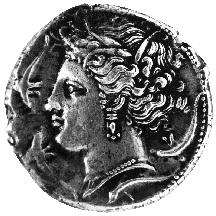



(20) Siculo-Punic - AR tetradrachm, 350-325 B.C., 17.08 g. (inv.
91.041).
Obverse: Head of Arethusa l., wearing triple-drop earring,
necklace, and wreath of reeds, surrounded by four dolphins.
Reverse: Head of horse l., palm tree; ![]() in Punic letters:
People of the Camp.
in Punic letters:
People of the Camp.
Provenance: Ex Fred V. Fowler collection; Stack's, 1969.
Bibliography: G.K. Jenkins, "Coins of Punic Sicily,"
Part 3, Schweizerische Numismatische Rundschau 56 (1977) 5-65.
Carthage, a Phoenician settlement on the coast of northern Africa, began
to compete with the Greeks for control of Sicily in the fifth century B.C.
Its interference there eventually led to the Battle of Himera in 480 B.C.,
in which combined Greek forces soundly defeated the Carthaginians. The Carthaginians
returned at the end of the fifth century, destroying Himera and other Sicilian
cities. The Syracusans resisted them throughout the fourth century, confining
them to the western part of the island, where they minted coins to pay their
troops. The coins are therefore called Siculo-Punic; the term Punic to refer
to the Carthaginians comes from the Latin Punicus, meaning Phoenician.
For the Siculo-Punic coins, the Carthaginians adopted a combination of Greek
and Carthaginian types, with Punic inscriptions like the one on this tetradrachm,
apparently indicating the minting authority, "the people of the camp."
The Arethusa type by Euainetos on Syracusan dekadrachms of the early fourth
century (see no. 19) was used as a model for the
obverse. The head is very close in all its details to the original, but
the thick chin and lack of definition in the dolphins identify it as an
imitation. The close copying of this type suggests that the Carthaginians
wanted these coins to circulate freely among the Greek coins of Sicily.
The reverse is a Carthaginian type. The horse's head probably refers to
a foundation legend of Carthage, in which the future site of the city was
determined by the discovery of a horse's head (Virgil, Aeneid 1.
441-444). It may also refer to the military use of the coinage. The palm
tree, phoinix in Greek, is a punning type that would permit Greeks
to identify the coin as Phoenician.
K.L.M.



All contents copyright (c) 1996.
Lawrence University
All rights reserved.